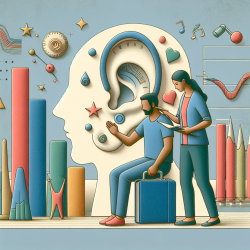As practitioners in the field of audiologic rehabilitation, it is essential to continually refine our skills and adopt new methodologies that can enhance the effectiveness of our interventions. One such methodology is Goal Attainment Scaling (GAS), a technique highlighted in the research article titled Clinical Report: Evaluating the Efficacy of a Group Audiologic Rehabilitation Program for Adults with Hearing Loss Using a Goal Attainment Scaling Approach.
GAS provides a structured framework for setting and measuring individualized goals in a rehabilitation setting. This technique involves all relevant parties—clients, clinicians, and significant others—in the goal-setting process, ensuring that the goals are specific, measurable, and attainable. Here are some ways to implement GAS in your audiologic rehabilitation practice:
1. Involve All Stakeholders
Involving clients and their significant others in the goal-setting process is crucial. This collaborative approach ensures that the goals are meaningful and relevant to the client's daily life. During the initial intake interview, ask clients to describe specific situations where they encounter communication difficulties. This will help in setting realistic and personalized goals.
2. Set Clear and Specific Goals
GAS requires setting clear and specific goals that can be quantitatively and qualitatively measured. Use a five-level attainment scale ranging from -2 (much less than expected outcome) to +2 (much greater than expected outcome). For example:
- -2: Answer the telephone 0% of the time when at home alone during the course of one week.
- 0: Answer the telephone 50% of the time when at home alone during the course of one week.
- +2: Answer the telephone 100% of the time when at home alone during the course of one week.
3. Monitor and Document Progress
Regularly monitor and document the client's progress towards their goals. This can be done through follow-up interviews, participant diaries, and self-assessment forms. Consistent monitoring helps in adjusting the rehabilitation plan as needed and provides valuable data for evaluating the program's effectiveness.
4. Use GAS to Foster Self-Efficacy
Goal setting is a powerful tool for building self-efficacy. By involving clients in setting and achieving their own goals, they become more aware of the actions they can take to improve their communication skills. This not only enhances their self-regulation but also increases their motivation to adhere to the rehabilitation program.
5. Encourage Further Research
While the current research supports the efficacy of GAS in audiologic rehabilitation, further studies are warranted to explore its long-term benefits and applicability in different settings. Practitioners are encouraged to contribute to this growing body of research by documenting their experiences and outcomes with GAS.
In conclusion, incorporating Goal Attainment Scaling into your audiologic rehabilitation practice can significantly enhance the effectiveness of your interventions. By setting clear, measurable goals and involving all stakeholders in the process, you can provide a more personalized and impactful rehabilitation experience for your clients.
To read the original research paper, please follow this link: Clinical Report: Evaluating the Efficacy of a Group Audiologic Rehabilitation Program for Adults with Hearing Loss Using a Goal Attainment Scaling Approach.










